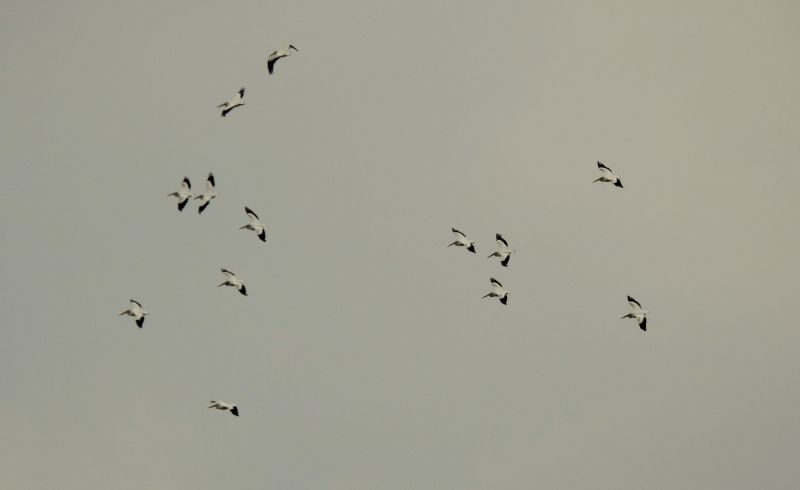American White Pelicans are on the move
American White Pelicans are on the move
This morning I turned my phone on and learned that there were pelicans at Fidler Pond here in Goshen. I have never seen any pelicans there, although we did see a flock this spring at Pigeon River Fish and Wildlife area. Since its only two miles to the pond from our place, I was soon pulling into the parking lot. I could see that there were some big white birds out in the middle of the small lake. Usually that means Mute Swans, but not today. There was already one local birder sitting on the grass watching the flock of 13 American White Pelicans.
The birds were floating in a tight group, and over the next hour they gradually moved to different parts of the lake. Gradually they became more active, splashing and flapping their massive wings, showing off the contrasting black-and-white patterns.
We had called other area birders who might be able to get free in the middle of the morning, and three of them showed up to enjoy the show. Lots of people use the park for walking, running and biking around the 1.5 mile gravel trail that encircles the lake. People would stop by to ask what the birds were, and seemed to enjoy looking through the spotting scopes where they could get close-up looks at the unusual, unexpected avian visitors.
Im not sure when the pelicans arrived at Fidler Pond, but at 11:15 in the morning they took off and circled slowly upward before heading off to the southeast. Who knows where they will stop next on their journey to wintering grounds, probably somewhere along the Atlantic or Gulf coast. White Pelicans can be found during the winter on the saltwater coasts of the southeast and also southern California, and on down both coasts of Mexico and Central America. They breed on lakes in Manitoba, Saskatchewan and Alberta, on down into Montana, the Dakotas, and parts of Wyoming, Utah, Idaho and Nevada. The pelicans that we see in Ohio and Indiana are almost certainly flying southeast from their breeding grounds, while others fly southwest toward the Pacific.
Although there is only one genus of pelicans around the world, there are seven different species. I find it interesting that our Brown Pelican is the only one that feeds by plunge-diving, similar to Northern Gannets and some terns. All the other pelicans, including our American White Pelican feed from the surface of the water. These six species all breed in colonies, feed in groups and often can be seen soaring high overhead like raptors. In the air, the black-and-white wings are impressive, but pelicans can be confused with Wood Storks and Whooping Cranes, which also soar and have black-and-white wing patterns.
American White Pelicans are much larger than Brown Pelicans and can weigh twice as much. Despite this, the largest pelican is the Dalmatian Pelican found in eastern Europe to China. They weigh from 22-28 pounds. All of the pelicans eat fish and need to catch a lot of fish to feed a young growing pelican. Contrary to what many people think, pelicans almost always eat fish as soon as they catch them, rather than carry them in their huge pouch. I have watched Brown Pelicans in Florida come up with a fish after a dive, juggle the fish into the right position and down it goes.
Its the time to watch for more fall migrants of all kinds. Warblers should be showing up now, along with all the other south-bound birds. Its a good time to be outside.
Good birding!
Bruce Glick
birderbruce@yahoo.com
330-317-7798




